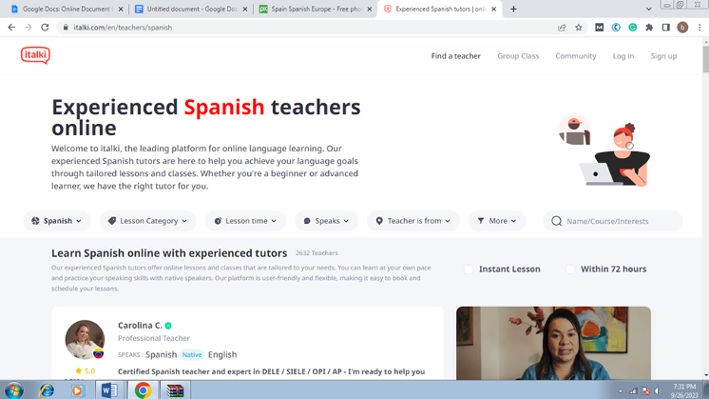Lunch in Spain differs from lunch in the United States. The large midday meal, or la comida, consists of several courses, each with five or six options. Traditionally, Spaniards do not eat “fancy” dishes on a daily basis, but they do enjoy a soup or pasta dish, salad, meat and/or fish, and a dessert, such as fruit or cheese.

What do Spaniards eat at lunch?
Entrantes: Appetizers
Appetizers, or entrantes as they are known in Spain, are simple dishes served to begin the meal, such as a plate of cheese, Serrano ham, or other popular cured meats and cheeses. Tapas are not called entrantes, despite the fact that some of the same dishes are consumed.
Pan con tomate (tomato bread) is a humble dish that is frequently served at the start of la comida. Toasty bread is rubbed with a garlic clove and ripe tomato, then drizzled with olive oil. Melon con jamon, an easy-to-make dish of skewered honeydew and Serrano ham combines the flavors of sweet and salty.

Primer Plato or Primero: First Course
This course can include a soup, such as sopa de pescado y marisco (fish and shellfish soup), or a vegetable dish, such as grilled asparagus, artichokes sautéed with gammon, mushrooms, and so on. Sopa de ajo (garlic soup), a traditional Castilian recipe, is a peasant-style bowl made with day-old bread, gammon, and garlic; each bowl is topped with a poached egg.

Pescados: Fish
The next course can be grilled or baked fish, or fish (pescado) or shellfish, such as clams or prawns with sauce or rice. The Spanish adore all kinds of seafood and expect it to be fresh, no matter how far they live from the coast.
Try rape al limon, which means “fish in lemon sauce,” or pescado frito con salsa de cebolla, which means “fried fish with onion sauce.” Bacalao con tomate (codfish in tomato sauce) is another tasty option. Of course, you can make the ever-popular paella de marisco, which is a delicious seafood rice.

It is also recommended to explore food culture in Spanish so that you can know the way Spaniards eat their food and the norms associated with it.
Carnes: Meat
Meats served in this course may include beef fillets (filetes), fillet mignon (solomillo), steak (entrecot), roast lamb (cordero asado), pork loin (lomo de cerdo), or roast suckling pig (cochillo asado). High-end restaurants may serve game birds such as quail (codorniz) or partridge (perdiz).
Fabada Asturiana, a bean and sausage casserole from northern Spain, or caldereta de cordero, a lamb casserole, are popular dishes to serve during the winter months. Cocido Madrileno is a stew named after the city of Madrid, where it originated, and it is made up of pig parts, beef, chicken, sausage, garbanzo beans, vegetables, and pasta. Estofado de Conejo, or rabbit stew in tomato sauce, is another popular recipe to try.

While visiting the Spanish restaurant, knowing Spanish phrases for travel will help you place your order confidently. Knowing these phrases will also allow you to carry out basic Spanish conversations.
Postre: Dessert
Some of you may not like thinking about a dessert after this much food, but with so many tempting options, you will want to make room. Desserts are typically composed of fresh, seasonal fruit, such as peaches in red wine, flan (a custard in caramel sauce), various types of ice cream cakes, or ice cream on its own. At the same time, espresso coffee will be available.

These are some of the traditional lunch foods in Spanish. Enjoying these food dishes in Spain requires you to know how to speak Spanish in the first place. If you are looking for an authentic language learning platform to master Spanish, we have a recommendation for you: italki.
Learn Spanish with italki
Now, at italki, you can learn Spanish online through Zoom classes or italki’s portal. Some amazing features can encourage you to choose this learning medium.
Spanish tutors with experience: Most of italki’s tutors are native speakers with years of experience. Based on your desired learning schedule and budget, you can choose a teacher from a list of experienced and professional tutors offering Spanish lessons online. All of these teachers will design personalized learning plans for you based on your specific requirements.

Find Your Perfect Teacher
At italki, you can find your Spanish tutor from all qualified and experienced teachers. Now experience the excellent language learning journey!
Book a trial lesson
Conversational learning formats: When you use italki, you will fully engage with the conversational Spanish tutors. The conversational learning style makes learning more engaging and enjoyable. You can choose the best learning format for your learning objectives and goals.
Flexible schedule: This platform recognizes people’s hectic schedules and provides much flexibility. You can take the online sessions in the comfort of your home.
Relevant content: The content offered by the tutors at italki is not only engaging but relevant as well. The content is based on real-life scenarios and practical examples, making learning easier.
Easy enrollment procedure at italki
The booking of lessons is a simple process. All you have to do is go to italki, create your profile, and fill out all of the information about your learning goals, preferred learning style, and schedule. After that, navigate to the ‘find a teacher’ section to search for all available Spanish instructors.

Choose your preferred tutor. You can also book a trial lesson at a discounted rate to get a feel for the teaching style. Every learner has a lot of freedom on this platform because they can choose their tutor, lesson time, learning mode, etc.
Frequently Asked Questions
What is a typical Spanish lunchtime?
In Spain, lunchtime typically falls between 1:30 PM and 3:30 PM. It is considered the main meal of the day.
What are some traditional Spanish lunch dishes?
Traditional Spanish lunch dishes include paella, gazpacho, tortilla española, pulpo a la gallega (Galician-style octopus), cocido (a hearty stew), and various types of tapas.
What are tapas, and are they a lunchtime dish?
Tapas are small, appetizer-like dishes, and they can be enjoyed at lunchtime or in the evening. They come in various forms, such as patatas bravas, albondigas (meatballs), and gambas al ajillo (garlic shrimp).
Is paella always served for lunch in Spain?
While paella is a popular dish in Spain, it is not necessarily served at every lunch. It is more commonly associated with regions like Valencia and coastal areas.
Conclusion
Every country or region has its own traditional food dishes. Exploring lunch foods in Spanish will help you understand the food culture, eating norms, and likings of Spaniards. You can also try out Spanish recipes to satisfy your taste buds.
If you are heading to Spain, getting a private online tutor through italki can minimize your language barriers. Book your lessons and start learning Spanish at your preferred schedule with your preferred learning style.
Want to learn a language at italki?
Here are the best resources for you!



















